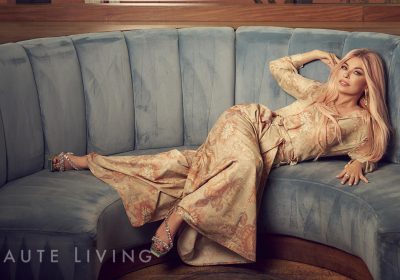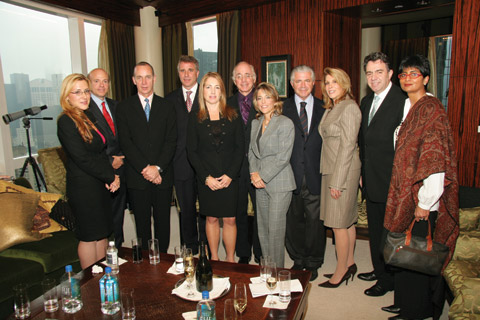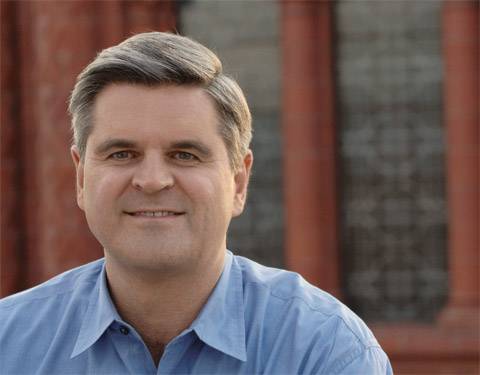Powered by Rolls Royce, in Partnership with Mandarin Oriental New York and Haute Living Magazine, The forces behind new york’s changing landscape gather for an intellectual discussion about the luxury market.
Photography by Wireimage.com
New York City is a destination, and I don’t see anything of the sort in New York City that I see in the rest of the country.
Roundtable Moderators
Seth Semilof { Haute Living Magazine }
Lockhart Steele { Curbed.com }
Roundtable Sponsors
Rolls-Royce
Mandarin Oriental New York
Haute Living Magazine
Dom Pérignon
On November 15th, Rolls-Royce Motor Cars, the Mandarin Oriental and Haute Living magazine participated in an afternoon of intellectual and culinary elegance, as real estate leaders converged at the striking and unparalleled setting of the Mandarin Oriental in the center of Manhattan for an interactive panel discussion that examined the hottest trends in the luxury market. Haute Living chose Lockhart Steele of Curbed.com and Seth Semilof, publisher of Haute Living to moderate this event. The event was attended by the forces behind the changing New York landscape, including Arthur Zeckendorf of Terra Holdings, Costas Kondylis of Kondylis and Partners, John Cetra of Cetra/Ruddy, Pamela Liebman of The Corcoran Group, Dottie Herman of Prudential Douglas Elliman, Susan de Franca of Related Residential Sales LLC, Hall Willkie of Brown Harris Stevens and Tony Goldman of Goldman Properties.
SETH SEMILOF In the New York market today, one thing we are seeing is smarter designs, as opposed to cookie-cutter brick buildings seen in the 70’s and 80’s. For example, we have the pod concept, and there is a lot more happening that is more creative. What do you think are going to be the new trends in the market?
JOHN CETRA To be smart means to always be evolving your ideas and thinking about what makes a building different than something you have done before. I think ten, fifteen years ago you could go to one building or another and all of them would essentially be the same. Nowadays, that model doesn’t work; every building has to be thought about as a unique product. Although we are selling space for people to live, and there are some elements that you find in every building, you have to be thinking: what’s your market? Who are you targeting? What are their needs? When it comes to elements of luxury, it’s really the budget and the concept combined with the design that you put together to create something that is different. In terms of trends, what I am seeing in the approach to a layout is, how do you create spaces that are unique, that take advantage of the site, take advantage of views? How do you maximize things?
LOCKHART STEELE One of things we obsess about on Curbed.com is the interiors of buildings, but let’s talk about the trends on the exterior of the buildings. Costas, can you touch upon this?
COSTAS KONDYLIS Glass buildings are definitely the current trend today. But, I see already a movement towards less glass. The thing is that there is an illusion when you see a whole glass building from the inside, as you only have about 50% of transparent glass; the rest is really columns, walls, and panels. You cannot have 100% glass, so we are creating an illusion of space, so you might as well use other materials than glass. So recently we started talking about stone again. But still, the #1 priority when you design a building is how to maximize the glass because we are trying to create light and air in the apartment. The first luxury in a building is really the space, and people like to see big rooms and a lot of light in the space.
Lockhart STEELE One thing I noticed is that once glass took off, some of these, to be kind, “lower-end” developments started mocking the look. Do you think this has an effect of buyer psychology, since the look has become so widespread that it doesn’t have the impact it did previously?
JOHN CETRA I think the glass is a material that gives you a lot of freedom. You could take a building and you could take a form, and you didn’t have to worry about where the windows were, where the columns were, and you could create a much more sculptural shape. You see it in many different glass buildings, and I think the ones that are done better take advantage of that fact, that suddenly you have hidden all the elements within, and you look at it just as a pure form, and you can get buildings that have multiple setbacks and the angularity becomes something you can play with, and the glass becomes this veil. And a perfect example of that are Frank Gehry’s buildings for IAC on the West Side where he took glass and folded it in ways so at night, it’s a totally different look than the day. That’s one of the things that glass does. I do agree with Costas, in that we don’t want to all do just glass now. You have to be careful with any product: In the right hands you can do something great, but that doesn’t mean that anyone can take advantage of it.
TONY GOLDMAN What we haven’t talked about is context and neighborhood. You asked the architects the question on a more general basis, but I think what is appropriate in a particular neighborhood may be inappropriate in another neighborhood. I think that developers and architects need to be very cognizant about what they are building, and where they are building it. They need to be aware how it plays itself into being a good new neighbor in a neighborhood. How is it non-arrogant, friendly and exciting? For example, we built Infill in historic districts and we’ve adaptively reused existing product. I think that is an additional challenge to the sense of creativity to be able to create something that is magnificent outside and has a fabulous relationship to everything around it. And I agree with what Costas is saying too: Luxury is big rooms, high ceilings, light and air and that’s important. But I think there is a difference now in New York real estate between luxury and super luxury. And I think that there is more money now in the customer base for the super luxury, where before it was unheard of to be selling $20 million to $25 million units.
COSTAS KONDYLIS Tony is talking about contextual architecture. That’s the planning of the building that complies with its surrounding, and if you have a good neighborhood you don’t want a foreign object landing there, but if you don’t have a good neighborhood, you want to distinguish yourself from your surroundings. We are trying to take it a step further now; we are trying to think contextually within the apartment. What is it that makes the essence of a West Side apartment? What is Chelsea all about? How do you enter modern apartments at 1200 square feet and get the feel that you are in Chelsea, that you are in the Village, you are the West Side, the Upper East Side? If it’s a pre-war building, it’s a pre-war building, whether it’s in Paris, London or New York, and it has the same principals, but once you get out of that area, you try to create contextualism within the design, using the marble, the types of sinks, etc. What is that that distinguishes SoHo from the Upper East Side? That is taking the contextual idea one step further.
SETH SEMILOF One of the reasons we are here is the changing of the New York skyline. In an interview with Mr. Aby Rosen, he credited accomplished architects for New York’s incredible changing skyline. He said that he believes New York has really grown into more of an international city. Dottie, what is your opinion on this comment?
DOTTIE HERMAN Regardless of what the media says, real estate today is still doing very well, but that doesn’t mean it goes up 22% every year. But I think you have a couple of factors: New York City is a place everyone wants to be. When it comes to real estate, people have seen the last ten, fifteen years that although the market might have dipped here or there, it has always come back. New York City is a destination, and I don’t see anything of the sort in New York City that I see in the rest of the country And I believe from Jonathan Miller’s reports that about 25% of all real estate volume is high-end real estate, that top 10% of the market, and I don’t think we are going to see a drop in it. I think that it is going to continue to grow. People identify themselves with who they are and where they live; that’s just part of the baby boomers and the generations after that.
LOCKHART STEELE Let’s come back to the changing fabrics of New York neighborhoods. Seth found a quote that I think is worth reacting to, said by an interior designer: “There are people who don’t identify themselves with existing neighborhoods, like the Upper East Side, or the West Village anymore.” He predicts that the borders are opening and people are reexamining the way they live, and that people are choosing more of a building lifestyle. Thoughts?
TONY GOLDMAN I don’t buy that at all. I think when people look to situate themselves, they want to know what neighborhood they are going to live in, and then what building in that neighborhood they are going to live in. While they may be attracted to a building, if that’s in a great neighborhood, that’s fine. If you are going to go to a great building in a neighborhood that is not going to suite you, you are not going to be a happy person, and I don’t think you are going to write the check. New Yorkers want to know, “What are my neighborhood restaurants, what are the conveniences that I can go to, how does it relate to if I have children, how does it relate to my lifestyle?” And that’s your core, because we are not dominated by a vehicle mentality, we are pedestrians, which is unlike most cities in the country. New York is in a market by itself and its neighborhoods are its powerhouse.
PAMELA LIEBMAN I have seen over the past ten years the way neighborhood boundaries have been erased and neighborhoods have become more similar to each other. There are certain aspects of living that you used to only get on the Upper East Side you can now get in neighborhoods throughout the city. When we first started doing the first new developments in Tribecca, what we learned (and this was back in the early 1990’s) was that people wanted this loft-style living, but they never came downtown simply for the fact that there were no doormen downtown. So what did we do? We got some buildings with doormen and all of a sudden you started reading these stories about how these Upper East Side-ers wanted a change of life, they wanted a more casual lifestyle, they didn’t want to be so formal, and they started coming to Tribecca. And then before all the “Starchitect” buildings came along and the Richard Meier buildings were done, no one ever thought of living on the West Side Highway, and people thought Louise was crazy when she said we were going to get $1500 a square foot over there. Yet people specifically went there for the fact of living in the Meier building. When we broke the sales record selling the apartment in [The Time Warner Building], I don’t think anyone would have thought the first $45 million apartment in New York City would have been on Columbus Circle, but they built a destination building that created something that didn’t exist and therefore set these new pricing boundaries.
TONY GOLDMAN I wouldn’t ever disagree with you, because I know better. But I would say that if the Meier’s buildings were not in the West Village with close proximity to the Meat Market District, they never would have sold. That building had a cool factor in its architecture and it had a cool factor in its neighborhood and it had a cool factor in that it was an emerging area of the Meat Market District. So I think there can be aspiration, and the aspiration of a building is to live up to a new lifestyle of a new neighborhood. So to me, the core of the neighborhood is the essence of where you really want to move, and then you can look within that neighborhood to the particular product that can suite you.
DOTTIE HERMAN Yes, the neighborhood is important, but the buildings today are offering a lifestyle within the building, which is a key factor. I think that Time Warner Building was a perfect example of what was really one of the early lifestyle buildings where everything was there. [Residents] can go to other places in the neighborhood, but everything is available in the building for them.
SUSAN DE FRANCA I agree with Dottie. Having been in the business for 25 years now, and a native New Yorker myself, when I began selling apartments, I was selling shelter and housing. But today we are selling an experience. I think because of the Internet, because of our fast paced world, people have less time, and when they go home, they want to have an experience, whether it is with their children in the playroom or in the entertainment lounge with their friends. They want a whole lifestyle experience.
TONY GOLDMAN The word we haven’t talked about is service. The service is what the next differentiated trend is going to be in real estate, and its going to be the inclusion of a hotel environment and the inclusion of hospitality in the residential living environment. This is the next step of what real super luxury is about. You see my colleagues in the hotel business now entering the real estate business, they finally got it right-that’s where the money is.
SETH SEMILOF Now the new trend has hoteliers taking over and creating the luxury lifestyle for residences. With Mr. Schrager running 40 Bond, Andres Balaz running William Beaver House and Cipriani running 55 Wall Street, people are looking to buy a building not just based on the architect, but on who is running it. The question is, is service the next trend?
ARTHUR ZECKENDORF I think service has been a concept that has been around since the Carlyle. There have always been resedentials on top of hotels, especially in Chicago, and San Francisco. This building (Mandarin Time Warner) is probably the first to offer new construction with a real hotel, and it did very well and is very popular. We are doing 15 Central Park West where we have our own private dining room with a 5-star chef, and we are able to give room service. We have a staff of 55, plus you get the option of having maids, you can valet your car. If the building is big enough you can have the services without strangers in your building like in a hotel. People love to be exclusive.
SETH SEMILOF Is this the new trend that the luxury consumer is asking for today? They want everything to be taken care of for them?
HALL WILLKIE I think what Arthur touched on that we haven’t talked about yet is different types of buildings, like this one (Mandarin Time Warner): it has commercial and retail and all those things, and that appeals to one group. Then you have people who would rather just live in a residential building, and that is the ultimate luxury to them. I think the unique thing that has happened with 15 Central Park West is that it has the great location and services without having any commercial component. It is a unique building in itself. It is a destination, and is all about the residences; it is not also a hotel. There are people who would prefer that, and people who would prefer this. Those are different parts of the luxury market. Luxury means a different thing to many New Yorkers. The majority of our market is co-ops (70%), and to [those owners], it might be the architecture, the pre-war details and the location. Those buildings really don’t have much service. They have a doorman, maybe an elevator man, certainly a live-in super, but some of the highest prices are achieved in buildings like that. So luxury means different things to different people. And the great thing about NY today is that is accommodating to everybody.
LOCKHART STEELE When there is a development going up in Queens calling itself luxury, how do you really define luxury? How do you market ultra-luxury when you are communicating to different markets out there? What are the certain break points in the market between what some people would call “low-end luxury” and what you would call “high-end luxury”?
SUSAN DE FRANCA I think luxury is defined by the product, by the value proposition and the quality. People who are subscribing to pay $3000+ a square foot have obviously made it, are well to do, and for the most part make educated buying decisions. Therefore they want to know the construction is quality, that the developer is reputable, has a proven track record, and will deliver. These customers of ours are very design savvy, they are art collectors and they like possessions and value them and at the end of the day want to know if it’s a legacy or something they can pass to their children, if it has significant value and adds to their life and to their investment portfolio, so I think it’s a lot easier to market a product that… I won’t say speaks for itself, because nothing really speaks for itself, someone has to be on the front line and that’s what we do.
COSTAS KONDYLIS What Susan is saying is very correct and brings to mind that as an architect, you design issues and concepts but you have to make sure you are enhancing the market value for the developer, and also for the owner of the apartment. You don’t want to do esoteric stuff that maybe means something to a certain group of architects and critics, but does not enhance the value. There has to be value-enhancing design.
HALL WILLKIE Sometimes the address is enough of a brand. New York has changed so much and there are new neighborhoods, places we never thought of living before, that now are terrific. If you are in a new location, you have to brand it, to give it some image, attach Rolls Royce to it, and tell the public what it is. But if I tell you 834 Fifth Avenue, I don’t have to say another word, that’s it. And that will be true in the future on these buildings; it will be, you know, Columbus Circle. You’ve made Columbus Circle a destination. So luxury is different things to different people and branding makes it possible.
PAMELA LIEBMAN And that’s the perfect example. We sold 40 Mercer without every writing one single ad for the property, because it was a very unique property. And with 40 Bond Street, we were targeting the audience that loves the architecture. You’ve taken on this other way of marketing your building that works perfectly for the building, but I think one of the mistakes that are in the marketplace now is with not just with the overusing of the word luxury, but with taking brands that don’t match with your building. When we sit down with a developer to work on the advertising of the building, we write a position statement for that particular building and figure out what works. If I have a building on the Lower East Side, I don’t call up Rolls Royce and say, ‘Hey, let’s do an event together, you are perfect for this building.’ That just doesn’t make sense. I have seen some really blatant examples of corruption, and I don’t know how these people are letting their brands be corrupted by associating themselves with buildings that have nothing to do with the brand.
LOCKHART STEELE Is Wall Street going to save us all, and continue to raise the prices of luxury real estate?
HALL WILLKIE Wall Street certainly is the source of the buyers. The majority of the buyers at Brown Harris Stevens are buying high-end stuff, 90% of them come from that financial industry, and the really top guys are from Hedge Funds.
LOCKHART STEELE How do their lifestyles impact the kind of things that you are designing?
TONY GOLDMAN They are looking for their dream places. They are making the money, and they are getting their sizeable hits, and they want to place it in something that is real. We actually have a group of folks who came out of our original clientele base who wanted to step from the 3000 to 5-or-6000 square foot place, as they were just getting married and having children, and want more space. They wanted a greater environment. We are currently building something that has its own backyard for nine families.
DOTTIE HERMAN I think you have very different demographics now. People are living longer and they don’t necessarily retire at 65, and they don’t want to go to the south full time, so you have people who might have left New York City now having second and third homes. Also, the new 50 is 40 and the new 40 is 30, and at 60 they are young and at the point where they say my kids are finally gone, and I think it’s MY time again, so I want to buy. And I also see, since I am from the Island, a lot of people left New York City when it was at a time not like it is now–it has gotten safer. Now their kids are gone, they have these big mansions on Long Island or in Jersey or Connecticut, and they are selling them and moving back to the city because they love New York.
HALL WILLKIE This goes to dollars per square foot and it’s all about supply and demand. The demand in New York is so great because it comes from all levels. There are young people coming in for their first jobs, and people in the middle of their careers and families staying and raising kids in the city, no longer leaving and the new 60/40 year olds are here, and people are retiring in NY. That’s what’s driving the market.
SUSAN DE FRANCA I would also say that the market is being fueled by expanding women buying in the marketplace, whether they are buying as single, professional women, or as in young families today, many of the mothers do work, and they would rather be close to their children’s doctors appointments, schools and opt to live in New York City. It’s a quality of life, instead of commuting two-to-three hours a day. So I see a huge trend: In the past 20 years, many women are working and many more women are successful on Wall Street and they now have the choices to buy their own apartments.
SETH SEMILOF Who are your buyers?
DOLLY LENZ The same buyers as everyone else’s: Wall Street people, a lot of international people. When I went into the business 20 years ago, it was build it and they will come and today that has evolved to build it, then give it an identity, then brand it, and hope and pray that they come. Now the buyers are calling me and saying, “I want to go there.” Buyers are looking on websites, and doing their own homework, and they are driving me, instead of the other way around. I think our next evolution is to truly differentiate ourselves website-wise. Advertising wise, the average consumer is looking at it saying what is the difference between this property and this one? I think we need to distinguish things a little better, and I think that is going to be the next evolution.
PAMELA LIEBMAN The international community has become much more important-It was always important, but is now more important to the New York City market, and with the weakness we have seen in the dollar, many of them feel that the New York market is down. So now we have a whole team now that travels the world. We took 40 Bond to Art Basel in Switzerland and we made three deals from that trip. We are really trying to expand the way we market our properties. We also try to differentiate our websites to get buyers to like us for different reasons. We just did a partnership with Zagat®, where if you come on the Corcoran.com website, you get free access to Zagat®- people want to know about where they are going to eat if they buy a property. Before you get your buyers loyalty, you have to identify who your buyers are. Goldman Sachs has an average bonus of like $6 million; we know a lot of that money is going into real estate and we are all going after it.
SETH SEMILOF What is your outlook for 2007?
COSTAS KONDYLIS I think there is a big demand for quality products.
PAMELA LIEBMAN I think we are looking at a big year for real estate in ’07.
JOHN CERTA No slow down.
DOTTIE HERMAN I think there is certainly more inventory, so you are going to see longer days on markets. I see a strong real estate market; it’s just that properties will be on the market a little bit longer.
HALL WILLKIE I believe that it is going to be a great market. It’s a healthy market, a stable market, a more balanced market, as brokers we tend to do more business in markets like that then when they are all one-sided, and that is what we are seeing today. We are seeing the market today is extremely strong with the balance and buyers have more say, and I don’t see anything that should prevent that from going forward.
TONY GOLDMAN Solidly bullish on New York. I think luxury and quality product and service will be the new differentiation for ‘07.
ARTHUR ZECKENDORF I just think the super luxury, which is Park, 5th, Central Park West, The Oceanfront in the The Hamptons and Palm Beach, there is just such limited space and that market is going to be very strong. There is an affordability issue. The interest rates with just pricing, and a first time buyer can’t really afford to buy like they were able to three-to-four years ago, so I am a little concerned, but I am also feeling very bullish.
SUSAN DE FRANCA I believe that 2007 will be a very strong market, but again speaking to the enormous amount of inventory that is in the market, I believe that it will separate the men from the boys and that the people who feel like they are getting value for their dollar and buying a quality product will persevere, and some of the other guys will be hanging out there a little bit longer.
DOLLY LENZ I predict a great year as far as brokerage, development, architecture, as far as everyone in this room is concerned we are all fine, great. I predict that it will start to get slower, because there is so much coming on the market, and it is so hard to differentiate what is across the street from you. I see that as challenging and I think it separates the men from the boys in our market as well.





















